The kestrel which occupies the southernmost territory almost always may be found sitting atop the spire of the emerging leaf of one of the Royal Palms which line the road near the entrance. It eats mostly insects, mainly grasshoppers and dragonflies, but also takes amphibians and reptiles such as small lizards, frogs and snakes. It also catches small rodents and songbirds:


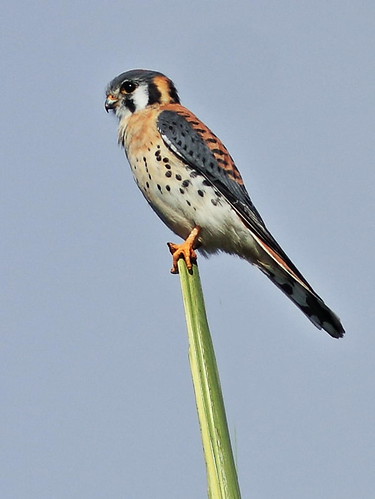
A Northern Mockingbird competes with a kestrel for a dominant perch:

Male searching for insects among the fruit of a Royal Palm
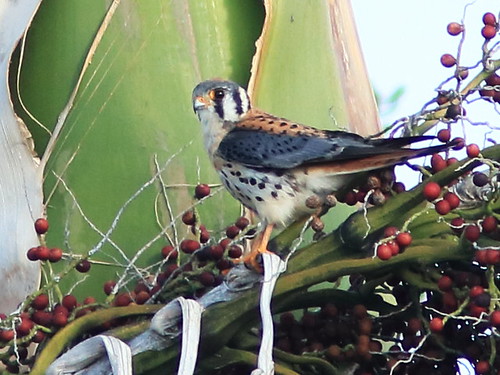
The other two kestrels tend to range either to the north or south of the lake which is about 3/4 mile north into the preserve. They often come into conflict along the lake shore, with the one whose territory is invaded most deeply usually chasing the other one away from the lake area. The central territory provides a variety of roosts from which its occupant can survey the the stretch of gravel road and its surroundings:
Power distribution lines run along this part of the track. Photos taken on wires disturb some purists, but I will settle for whatever view I can capture:



Small trees along the lake shore are also favored:

In the northernmost territory, I often find its occupant high on a lightning arrestor pole next to an electrical power sub-station:
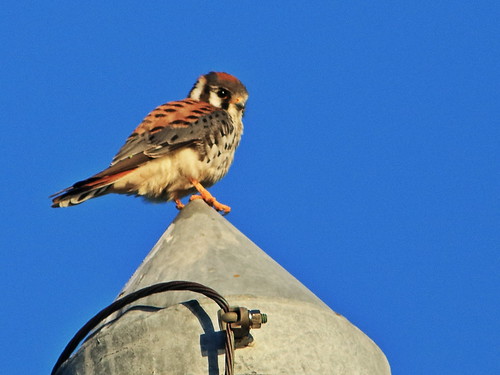
It also selects the top of one of the tallest trees nearby:
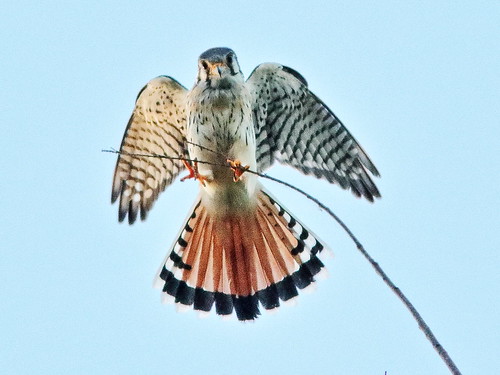
This particular territory was recently visited by another small falcon, a Merlin, an efficient predator of small to medium-sized birds:

.
With an average length of about 12 in (31 cm) and wingspan of 25 in (64 cm) the Merlin is slightly larger than the American Kestrel, North America's smallest falcon, which is 10.5 in (27 cm) long and has wings which spread to 23 in (58 cm). The Merlin has a bulkier, muscular appearance and its flight is energetic and direct, while the kestrel seems rather delicate and more buoyant in flight.
American Kestrel in flight:
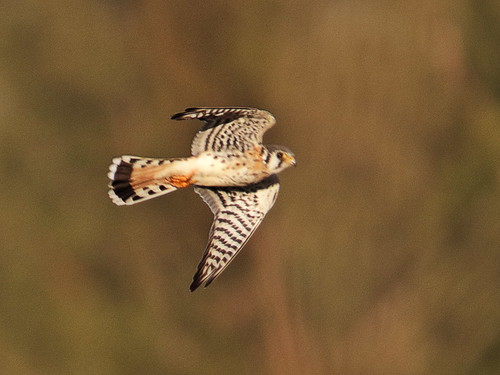
Merlin:

For several days, both falcons co-existed without signs of conflict:

The Merlin fanned its tail, possibly as a sign of aggression towards a grackle which landed (fearlessly) in an adjacent tree:
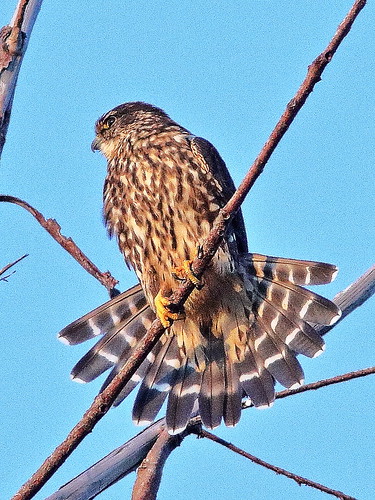
The male kestrel's plumage is especially colorful. His steel-blue wings contrast with copper-red tail and topside:

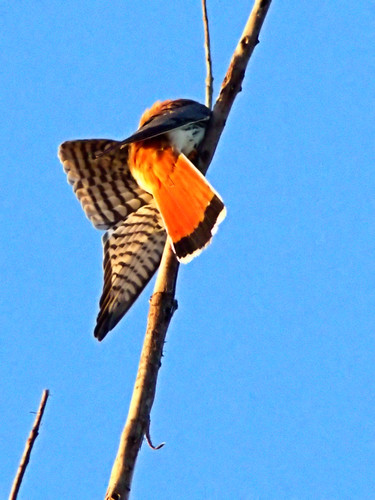
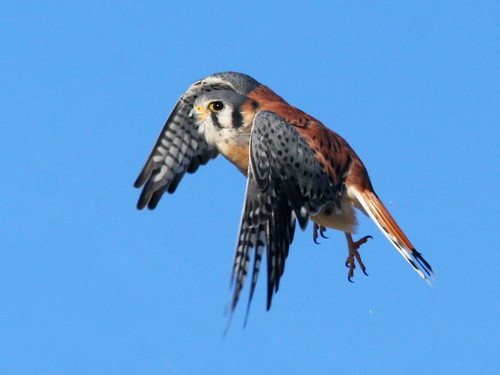
Nearly all the American Kestrels I have seen and photographed have been males. The female is also quite beautifully marked with barred brown wing coverts and matching back and tail:

There was a full Beaver Moon in mid-November as we started walking out about 40 minutes before sunrise. As usual, my child bride MaryLou was out ahead of me with her flashlight. (62 years ago, on November 22, 1957 I popped the question and we became engaged to marry). The Royal palms stand out against the dark sky in the southernmost winter territory of the kestrel:
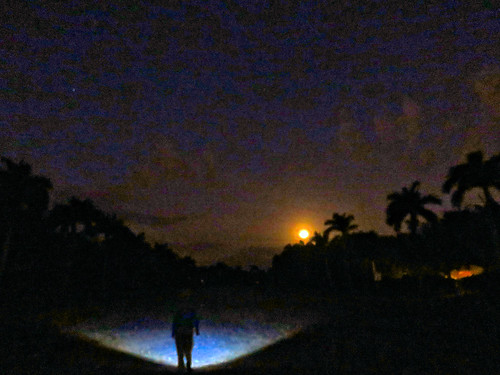
The Beaver Moon shines over the lake which is the zone of conflict between the north and central territories of the American Kestrels:
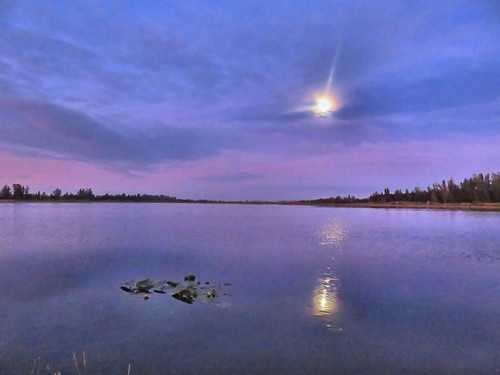
Zebra heliconian, Florida's State Butterfly on Firebush (Hamelia patens) flower:

= = = = = = = = = = = = = = =
Linking to Misty's CAMERA CRITTERS,
Linking to Eileen's SATURDAY'S CRITTERS,
Linking to SKYWATCH FRIDAY by Yogi, Sylvia and Sandy
Linking to WEEKEND REFLECTIONS by James
Linking to BirdD'Pot by Anni
Linking to Our World Tuesday by Lady Fi
Linking to Wild Bird Wednesday by Stewart
Linking to Wordless Wednesday (on Tuesday) by NC Sue
Linking to ALL SEASONS by Jesh
________________________________________________
Please visit the links to all these memes to see some excellent photos on display
________________________________________________
Your pictures are not only excellent as usual, but also cast a fascinating light upon the way that the birds behave and interact. I would suggest writing a book about the birds of your bit of Florida, except that I guess your blog already fulfils that function. I wish I could find one that covers our birds here in Britain in a similar way to yours.
ReplyDeleteThe Kestrel is a beautiful bird, and you have some wonderful captures. I like the Merlin fan tail shot!
ReplyDeleteI don't recall ever seeing a kestrel around here. The butterfly photo is beautiful!
ReplyDeletefascinating, beautiful photos of the wild birds and the butterfly. Interesting your stories
ReplyDeleteThe moon picture in the lake are great !!!
greetings Elke
Hello, awesome post on the Kestrel and I would love to see the Merlin. Your photos are beautiful, well done. Happy Anniversary of your engagement. Pretty sky and butterfly. Thank you for linking up and sharing your post. Enjoy your day, wishing you a happy weekend. PS, thanks for the visit and comment on my post.
ReplyDeleteBeautiful!
ReplyDeleteHave a wonderful weekend!
I am always so anxious to see your posts! We see Kestrels often here but I'm not sure we've seen a Merlin. We have trouble with the Hawk IDs! lol How wonderful that you have had such a long happy marriage and still love to get out and do walks together. Makes me smile!!! Enjoy your weekend and this gorgeous weather!
ReplyDeleteWhat a great looking little bird - and rather more colourful than the Kestrels we have here.
ReplyDeleteHope all is well.
Cheers - Stewart M - Melbourne
My...it was like, there for a minute, like I stumbled into Wikipedia on the falcons' site! Extraordinary photos of them, terrific input of your knowledge also. (I like ANYTHING that eats snakes by the way)love the flashlight image of your "child bride"...and congratulations on 62 years of your proposal.
ReplyDeleteThanks for linking up this weekend.
Beautiful captures
ReplyDeleteFalcons are beautiful birds. I especially liked the picture with the fanned tail. - Margy
ReplyDeleteBeautiful photos of two handsome falcons! Have a wonderful week!
ReplyDeleteKenneth you have obviously taken great time and trouble to work out and to then detail the daily habits of your kestrels. I called them "your kestrels" because I think they became quite accustomed to your presence and the click of your camera. Superb pictures, kestrels and Merlin.
ReplyDeleteAmazing photos of beautiful birds... and a butterfly, too. Thanks for posting them for all to enjoy.
ReplyDeleteThe Kestrel is such a colorful and beautiful bird. So bird do have feelings!(the spread tail!) Love your almost romantic capture with the kestrel close to the red berries!
ReplyDeleteMany thanks for posting this for All Seasons! The butterfly is beautiful too. If it were here, it would be hiding. because believe it or not it's snowing here right now. Thank you for the compliments toward hubby's carpenter skills, he has quite a history in that:) Have a lovely week!
Fabulous photos, I do love falcons. Diane
ReplyDeleteMarvelous bird photos and the skies are fantastic!
ReplyDeleteThese are some great shots! I would have spent a lot of time taking lots and lots of photos, too! I love your captures.
ReplyDeleteMy Corner of the World